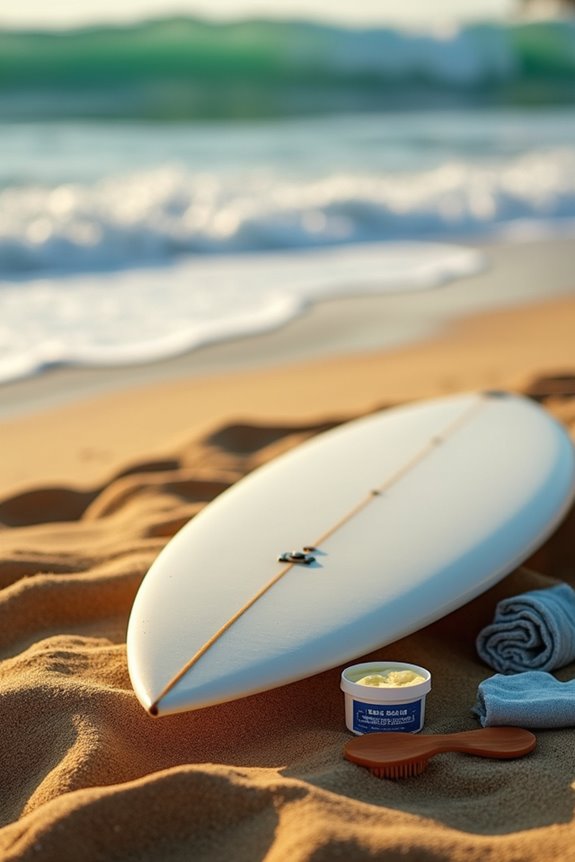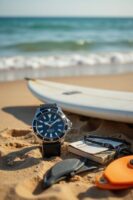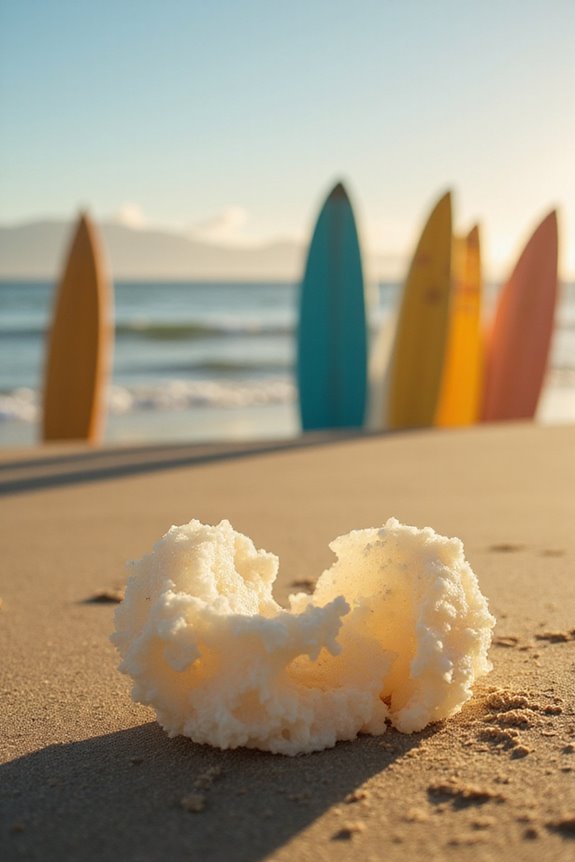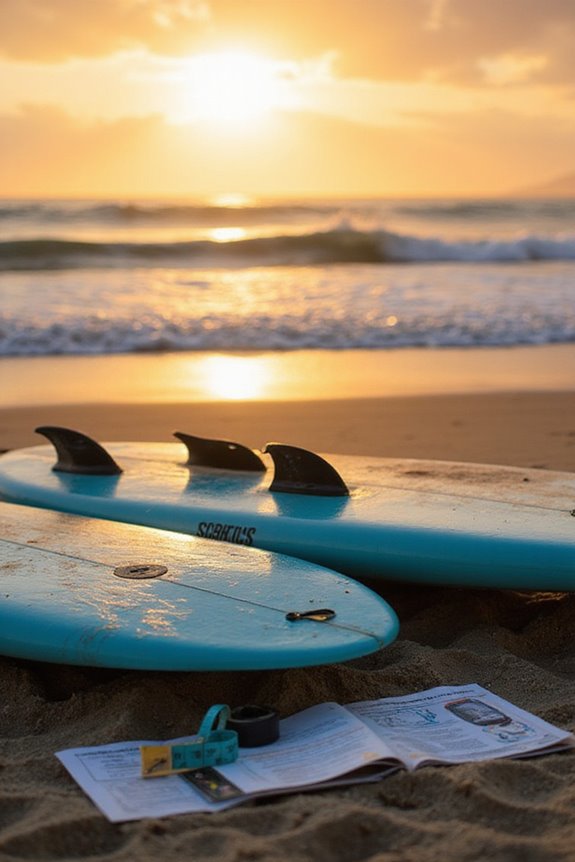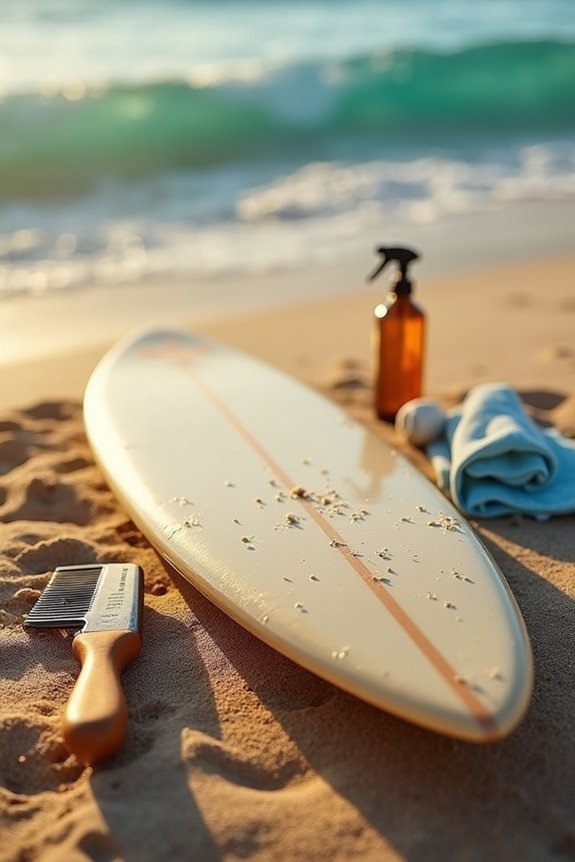To wax a surfboard, we start by preparing the board on a stable surface in the shade. We clean the board and choose the right wax based on water temperature: cold, cool, warm, or tropical. Next, we apply a basecoat in circular motions for an even layer, followed by a topcoat focused on high-traffic areas for grip. Regular maintenance, such as checking wax condition and replacing the basecoat, is essential for peak performance. More detailed techniques and tips await.
Key Takeaways
- Gather all necessary tools including a wax comb, wax remover, cloth, and selected wax type based on water temperature.
- Clean the surfboard thoroughly to remove old wax and ensure a dry, dust-free surface before applying new wax.
- Apply a basecoat wax in circular or cross-hatch motions for an even, thin layer to improve grip and performance.
- Use small circular motions to apply the topcoat wax, focusing on high-traffic areas for optimal traction.
- Regularly inspect and maintain the wax, replacing the basecoat monthly for frequent use and softening wax for easy removal.
Preparing the Surfboard for Waxing
Before we start waxing our surfboard, it’s vital to properly prepare its surface. First, we need to gather our cleaning tools: a wax comb, wax remover, and a cloth. We can also use natural abrasives like fine beach sand or coconut water for stubborn residues.
Next, let’s focus on workspace preparation. We should select a flat, stable surface to guarantee even application. It’s important to check the temperature and environment, as working in the shade can help with wax handling.
Finally, we need to conduct a tactile inspection of the surfboard to verify it’s dry and free of dust. This step is essential to make sure the new wax adheres effectively. Additionally, regular cleaning of our wax comb maintains its effectiveness and ensures optimal application of the wax.
Selecting the Right Wax
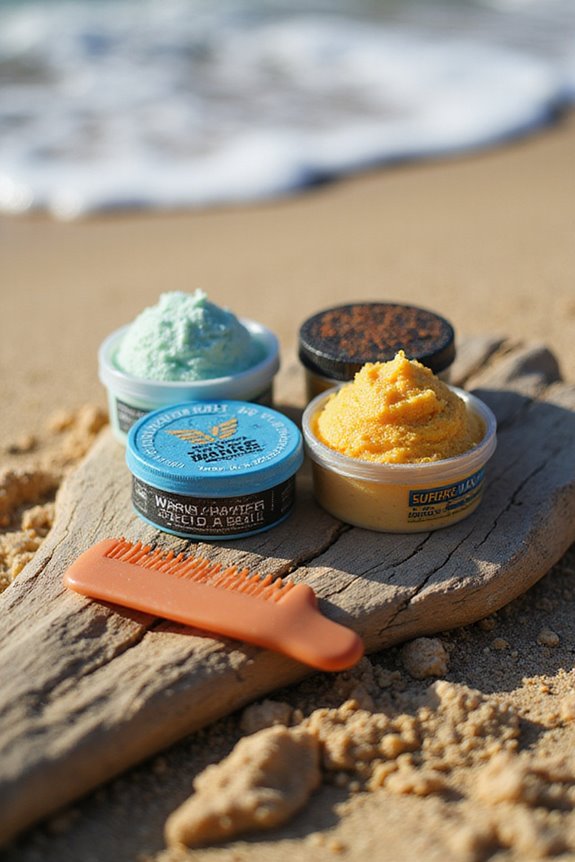
Choosing the right surfboard wax is essential for optimizing our performance in the water. We must consider different wax types based on water temperature.
- Cold Wax: For water below 58°F (14°C), soft and easy to apply.
- Cool Wax: Suits temperatures from 54°F to 69°F (12°-20°C), ideal for early spring and late fall.
- Warm Wax: Harder, for 63°F to 78°F (17°-25°C), perfect for early summer and early fall.
- Tropical Wax: The hardest, for water above 75°F (24°C), designed for hot climates. Additionally, selecting wax based on temperature compatibility is crucial for maximizing grip and performance.
Applying the Basecoat Wax
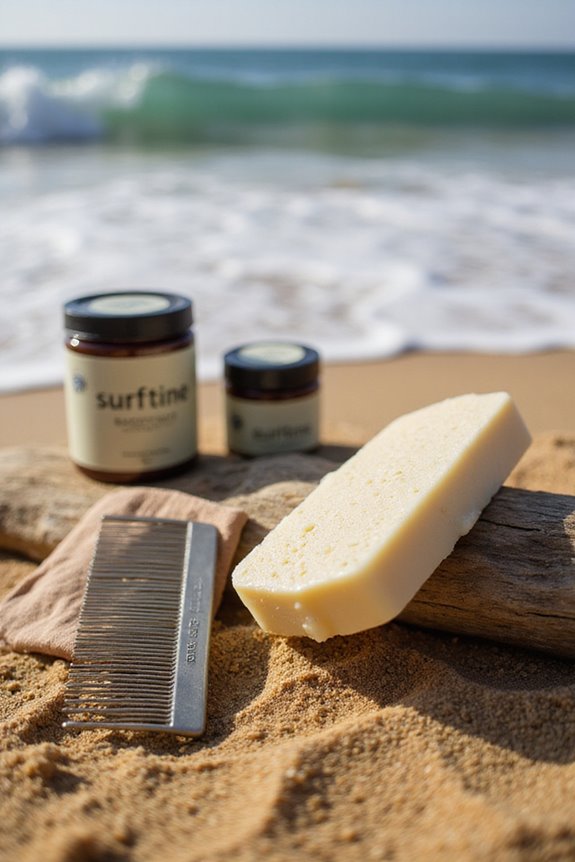
To guarantee peak performance, we must apply the basecoat wax correctly before adding the topcoat. The basecoat offers several benefits, including better adhesion, smoother application of the topcoat, and enhanced grip.
Preparation Steps
- Clean the surfboard surface thoroughly to remove old wax.
- Use a wax comb to scrape off wax in straight, vertical strokes.
- Allow the board to dry completely.
Application Techniques
- Apply the basecoat in circular or cross-hatch motions, ensuring an even, thin layer.
- Cover the entire standing area, creating noticeable bumps for traction.
- Use a single block for a consistent application; avoid excessive bulkiness.
Regular maintenance of the basecoat helps improve overall wax longevity and performance during surf sessions. Additionally, using a quality basecoat like Sticky Bumps can enhance grip across a wider range of water conditions.
Applying the Topcoat Wax

When we apply the topcoat wax, it’s essential to select the right wax type based on the current water and air temperatures to guarantee ideal grip. For warm conditions, we use tropical wax, while cool or cold conditions require appropriate wax to prevent slippage.
We’ll apply the wax using small circular motions with gentle to moderate pressure, building up topcoat thickness to create effective wax bumps. This technique enhances wax friction, providing better traction. Concentrating on high-traffic areas, like the center and tail of the board, guarantees consistent grip. Remember, a well-applied topcoat not only improves our performance but extends the wax’s longevity, so let’s regularly inspect and reapply as needed for best results. Additionally, using a reef-safe sunscreen while surfing can help protect both your skin and the marine environment.
Waxing Patterns and Techniques
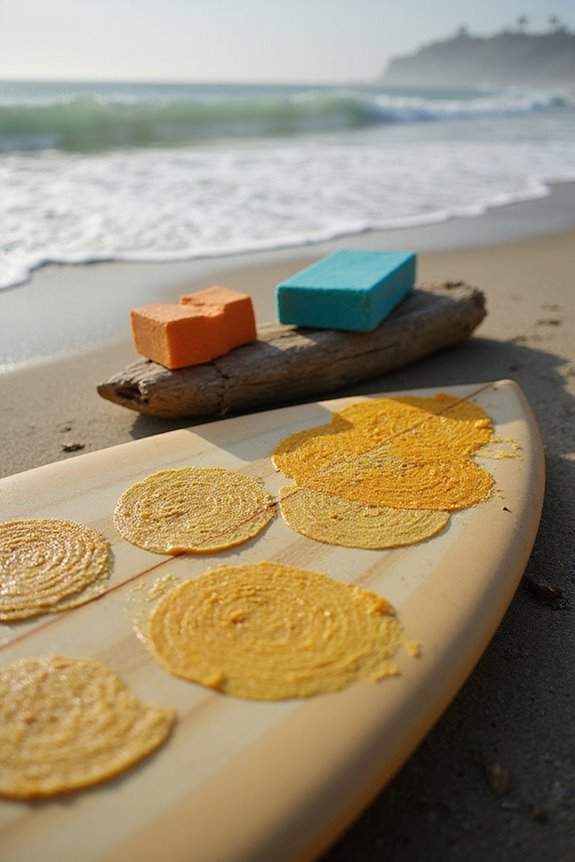
Four primary waxing patterns can enhance our surfboard’s grip and performance: circular, straight line, crosshatch, and freestyle.
- Circular: We apply wax in small, overlapping circles, which builds texture and promotes even coverage.
- Straight Line: This technique involves applying wax in long strokes parallel to the board’s rocker, ensuring coverage from nose to tail.
- Crosshatch: By creating a grid-like pattern with diagonal strokes, we increase surface friction for maximum grip.
- Freestyle: This method allows us to combine any of the above techniques, focusing on specific areas according to our style.
For all these waxing patterns, using light, multiple passes will help create effective application techniques and enhance our overall surfing experience. Additionally, ensuring that the wax is suitable for cold water conditions can significantly improve traction and grip during your sessions.
Maintenance and Removal of Surfboard Wax
Maintaining and removing surfboard wax is vital for peak performance and longevity. We should regularly check our wax condition based on maintenance frequency. For frequent surfers, replacing the basecoat monthly guarantees ideal grip, while occasional surfers can keep the same coat until water temperature changes.
To perform wax removal, we can warm the surfboard in sunlight or use a hair dryer to soften the wax. Using a wax comb, we carefully scrape off the softened wax, employing gentle motions to avoid damage. After scraping, cleaning remaining residues with mineral turpentine or coconut water is essential. Regular removal of old wax prevents buildup, enhances performance, and keeps our surfboard in prime shape for every session. Additionally, maintaining the ideal weight limit for a surfboard ensures that the board performs optimally during use.
Tips for Optimal Waxing
After ensuring our surfboard is free of old wax, we can focus on applying fresh wax for ideal grip and performance. To achieve best results, we should consider the following:
- Waxing Frequency: Regularly check and reapply wax, especially after multiple surf sessions. This prevents excessive wear and maintains grip.
- Application Technique: Use the criss-cross method for initial layers and follow with small circular motions to enhance bump consistency.
- Environmental Impact: Wax indoors or in shaded areas to avoid melting. Cooler conditions help preserve wax texture.
- Target Areas: Focus on the tail, front foot region, and rails for maximum traction.
Common Mistakes to Avoid
When waxing our surfboards, it’s crucial to avoid common mistakes that can hinder performance and safety. First, we should verify we cover grip zones completely, especially the rails and areas where our feet and hands contact the board. Neglecting these spots leads to slipping and reduced control.
Next, let’s not make waxing errors by using the wrong wax type for water temperature or skipping the basecoat. We also need to remove old wax thoroughly before applying new wax for better adhesion. Additionally, waxing on uneven surfaces or in direct sunlight can damage the board or degrade the wax. Finally, we must maintain our wax regularly to prevent buildup, guaranteeing peak performance during our surf sessions.
Frequently Asked Questions
How Often Should I Wax My Surfboard?
We’ve all wondered about waxing frequency, right? In ideal conditions, we should check our board regularly. Frequent surfers might wax monthly, while others can stretch it longer, depending on water temperature and usage.
Can I Use Candle Wax Instead of Surf Wax?
We can’t recommend using candle wax instead of surf wax. Its effectiveness for traction is poor, compromising our surfboard performance and safety. Let’s stick to proper surf wax for the best grip and control while riding waves.
What Happens if I Mix Different Wax Brands?
When we experimented by mixing Sticky Bumps and Sex Wax, we noticed a decline in our surfboard performance. Wax brand compatibility is essential; inconsistent textures can lead to reduced grip and overall performance impact.
Is There a Specific Order for Applying Basecoat and Topcoat?
When it comes to basecoat application and topcoat techniques, we should always start with the basecoat for stability, then apply the topcoat for enhanced grip. This order maximizes our board’s performance in the water.
Can I Wax a Surfboard in Cold Weather?
Imagine our surfboards gliding through icy waters; in cold weather, we can still enjoy the ride! We’ve got wax application tips that guarantee grip despite cold weather effects—just choose the right wax for peak performance.

